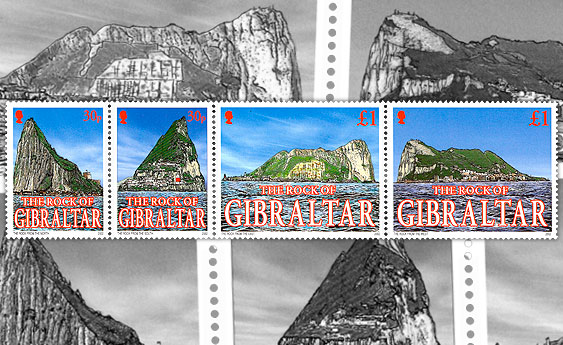Home -> Stamps -> 2002 -> Rock of Gibraltar
We also recommend:
Rock of Gibraltar

Rock of Gibraltar (view technical specs)
The Rock of Gibraltar stamps are the first ever stamps in the world to be produced with actual rock incorporated on the stamps. Limestone was bored out of the centre of the rock, as accessed by the Rock's World War II tunnels. Thelimestone was first powdered and then sintered within the image of Gibraltar where there is rock showing. The printing process used was offset lithography together with thermography layer or limestone.
Thermography machines are constructed with three sections connected by a through conveyor. The first section applies powdered polymer to the entire sheet followed by a gentle vacuuming to remove the excess powder from the non imaged and dry ink areas. The areas selected for raised printing are printed with inks that do not contain dryers or hardeners so that they remain wet during the application of powder. This ink will be dried or hardened later during the heating process. The vacuum system has a throughput limit on the order of 90 to 100 feet per minute. The sheet is then conveyed through a radiant oven system and heated to about 350° F. The heating process takes on the order of 2.5 to 3 seconds. During this time, the substrate (usually a paper product) has a peak in IR radiant absorption at the frequency (temperature) used in this process. Through conduction from the contact with the paper, the powder temperature rapidly increases and starts filming at the edges of the selected raised printing areas. When the center of the largest filmed areas reaches a sufficient quality level, the process speed adjustment and heater intensity are such that the product will be exiting the heater. When the polymer filming is at the proper quality and before combustion occurs, the sheet is immediately run into a convection cooling section where the filming action is stopped at that quality level.
This process is sometimes produced using a hand powdering process. The substrate with the wet ink areas selected for the effect are dipped into the powdered polymer. The sheet is tilted back and forth, rolling the powder across the image. The excess powder is removed by raising the substrate to a verical position and lightly tapping the back. The powdered sheet is then fed into a radiant heating system as above at a speed to achieve a quality filming. In the case of craft applications, heating can even be achieved by carefully using a hair dryer.
It is commonly used on letterheads, business cards, greetings cards, gift wrap, packaging and can also be used to print braille text. It is even sometimes used in diploma printing as an attractive alternative to the more expensive engraving option.
Technical Specs
| Design: | Anselmo Torres |
| Illustration / Photography: | Anselmo Torres |
| Printer: | Cartor Security Printer |
| Process: | Offset Lithography + Thermography |
| Colours: | 4 cols. + limestone rock |
| Stamp size: | 30 x 40mm & 50 x 40mm |
| Issue date: | 2002-09-15 |
| Stamp Values: | 30p, 30p, £1, £1 |













